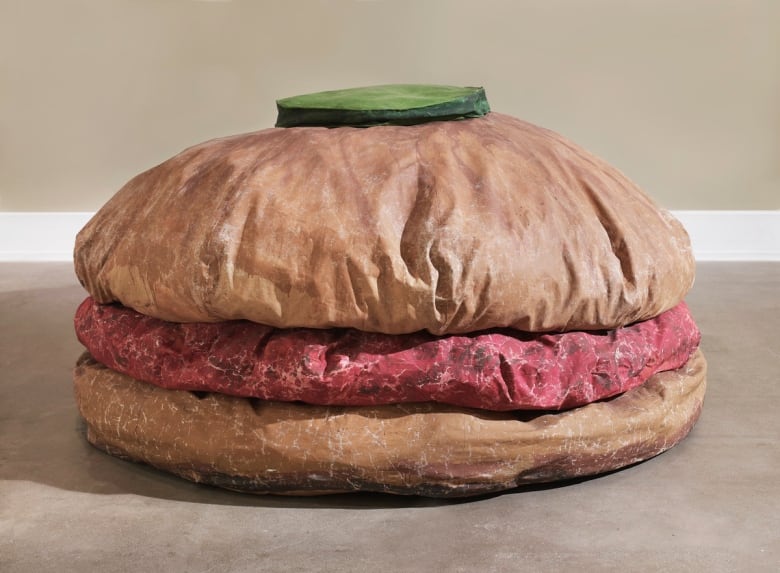Pop artist Claes Oldenburg transformed everyday objects into towering monuments
Oldenburg died this week at the age of 93

Claes Oldenburg will be remembered as "an extraordinary man" for his impact on the art world and beyond, says an art gallery curator and long-time collaborator.
"Claes was an extraordinary man, an incredible artist and someone who we will all sorely, sorely miss," Steven Henry, a senior partner at the Paula Cooper Gallery in New York, told As It Happens guest host David Cochrane.
Henry worked on projects with Oldenburg for decades, including the artist's final piece earlier this year.
The Swedish-American sculptor, who disrupted the art world with his whimsical depictions of everyday objects and massive pieces of public art, died this week at the age of 93.
"The loss does feel profound for those of us in the art world but … beyond the art world as well, because his work touched so many," Henry said.
"Someone will say, 'Meet me at the baseball bat,' or 'Meet me at the clothespin,' and I think they may not even realize that's a Claes Oldenburg, yet they're delighted and enraptured by the piece."
Inspired by everyday items
Oldenburg was born in 1929 in Stockholm. He grew up living between Sweden, Norway and the U.S. due to his father's job postings as a diplomat. Oldenburg studied literature and art history at Yale University and then went on to the School of the Art Institute of Chicago.

In 1956, the budding artist moved to New York City. He was captivated by the city streets that were decorated with display windows, graffiti, advertisements and trash.
Over the next few years, his artwork was inspired by the everyday items sold at a bodega. He made "soft" sculptures, made of canvas or vinyl and filled with foam, that took the form of items like sandwiches, oranges and cigarettes.
"You have a great one in Canada," Henry said, referring to Oldenburg's 1962 work, Giant Hamburger.
"It's hilarious. It's, you know, sewn fabric that's been painted. And then you kind of encounter it, you're like: 'Wait, that's a hamburger!' and, 'What's it doing in a museum?' It's funny and it's subversive, I think."

Giant Hamburger was purchased by the Art Gallery of Ontario in 1967. At the time, some people didn't think the sculpture, which was renamed Floor Burger, belonged in the museum. Some students responded by leading protests while carrying a nine-foot ketchup bottle.
"Oldenburg's art continues to inspire and challenge," AGO curator Xiaoyu Weng wrote in an email to As It Happens.
"The work has generated many stories, some controversial (like the initial protest from the public against the work's acquisition due to its then experimental nature) and some joyful (there is a little boy who came two years in a row to see the work on his birthday)," wrote Weng, who is the AGO's Carol and Morton Rapp curator of modern and contemporary art.

Henry remembers Oldenburg for his wry sense of humour, which the artist infused into his work. In the '60s, Oldenburg made a name for himself in New York's explosive pop art scene with his outsized, ordinary objects inside Manhattan's tiny gallery spaces — a radical departure from the traditional displays at the time.
"I think he was commenting on this notion of the representation of power and how traditionally monuments have been these visualizations of typically men, standing or on horseback, and generating or at least communicating this notion of power and hegemony," he said.
"And I think he's saying, 'Okay, these other things can also be aggrandized in a way that, you know, maybe kind of gets us to question what is a monument?'"
Art à la carte
Food featured prominently in Oldenburg's work over the years — so much so that he carried a sketchbook with him to the dinner table.
"He would pull it out just in the midst of a conversation," Henry recalled. "And he would start drawing. And often it would be a sort of fanciful take on a meal."
Part of the reason why he drew his food was because his wife, Coosje van Bruggen, had food allergies and had to follow a plain diet.
"He would draw these wonderful, fantastic food dishes that she could consume visually," Henry explained. "We actually did a show called Images à la Carte, which was an exhibition of these very sweet drawings that he did for Coosje…. It was a very sweet and loving tribute to her."
Van Bruggen was also a sculptor and worked in collaboration with Oldenburg on several monuments, including the Clothespin in Philadelphia, Saw, Sawing in Japan and Apple Core in Israel, among others. She died in 2009.

According to Henry, Oldenburg stopped working on large-scale projects after his wife died. But a few years ago, when Henry spoke with Oldenburg about what projects he wanted to complete, a project from 20 years ago came up.
Oldenburg created a giant red shovel for his property in France. He wanted to create another shovel like it in blue, but never got it done until earlier this year. When the idea took shape, it was finally planted at Rockefeller Center in New York City.
"It became this metaphor of a rebirth," Henry said.
"He always loved the way the work was seen amongst buildings … where people could really engage with it one-on-one. We were thrilled that it was able to be done before he passed."
Written by Mehek Mazhar. Interview with Steven Henry produced by Chris Trowbridge.
